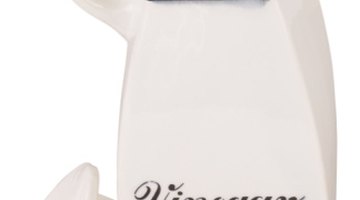How to Get Rid of White Powder Mold on Plants With a Vinegar Mix
Dusty white or grey spots on the leaves, stems, flowers or fruit of plants and shrubs is caused by fungus. If left untreated it easily spreads to become a thin, white powdery coating on the entire plant. Young foliage and shoots are the most susceptible to excessive powdery fungal growth.

Early signs of the disease are leaf curling and twisting. Powder mold does not kill the plant but will hasten its defoliation, prevent normal flowering and cause early dormancy. It is common on all types of ornamental plants and flowers. Lack of adequate air circulation contributes to the development of powdery mildew. Vinegar is an effective home remedy for the problem.
Things You Will Need
- White or cider vinegar
- Hand sprayer
Tip
Space plants for good air circulation. Overcrowded conditions set the stage for fungal problems. Use mature compost as part of the potting soil mix and as outdoor fertilizer. Compost helps soil balance fungal and bacterial populations and prevents disease.
Warning
Roses, phlox and zinnia are highly susceptible to powdery mold and should be planted in areas that receive full sun. Do not handle or work with plants when the foliage is wet. This may spread fungi spores. Avoid overhead water sprinkling that leaves foliage damp. Water in the morning only.
-
Pour 2 tbsp. undiluted vinegar into the spray bottle container. Hand-held plastic sprayers are easy to use for household plants and hose-end sprayers work well for larger outdoor areas. Use one part vinegar to 20 parts water in any size container.
-
Shake or stir the water-vinegar mixture and begin to spray. Cover all parts of the plant, especially the underside of leaves. Vinegar is a contact fungicide that is effective only when fungi spores are sprayed directly.
-
Repeat the application weekly until the powdery mold is gone. Continue to monitor plants for small round dots of white or gray fuzzy growth, which indicates a re-emergence of the fungus.
The Drip Cap
- Dusty white or grey spots on the leaves, stems, flowers or fruit of plants and shrubs is caused by fungus.
- Hand-held plastic sprayers are easy to use for household plants and hose-end sprayers work well for larger outdoor areas.
- Repeat the application weekly until the powdery mold is gone.
References
Resources
Writer Bio
Joan Norton, M.A., is a licensed psychotherapist and professional writer in the field of women's spirituality. She blogs and has two published books on the subject of Mary Magdalene: "14 Steps To Awaken The Sacred Feminine: Women in the Circle of Mary Magdalene" and "The Mary Magdalene Within."
Photo Credits
- Hemera Technologies/PhotoObjects.net/Getty Images
- Hemera Technologies/PhotoObjects.net/Getty Images
More Articles



